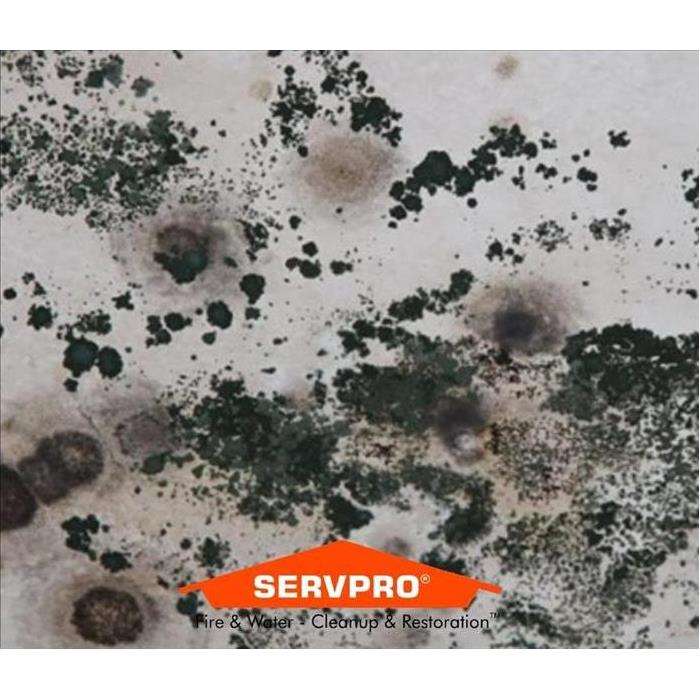Recent Mold Remediation Posts
Types of Mold Found in Homes and Businesses
2/28/2024 (Permalink)
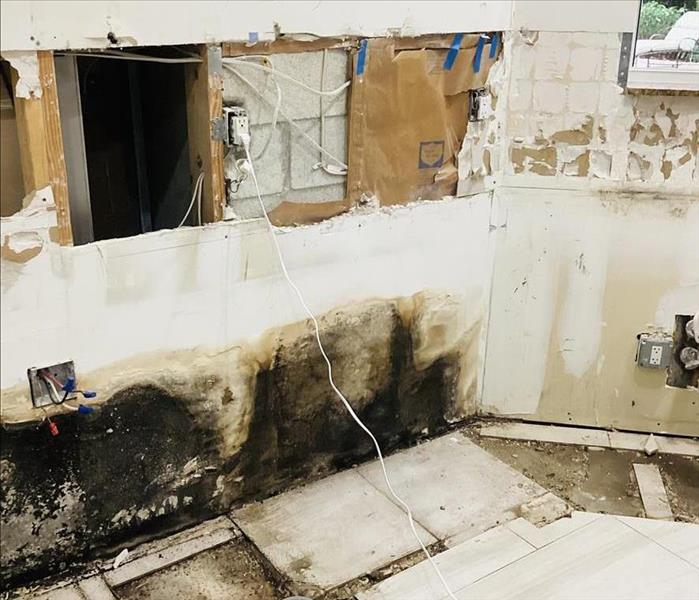 Mold was discovered in this Parkland home during a kitchen remodel. SERVPRO was contacted right away and was able to professionally remediate it.
Mold was discovered in this Parkland home during a kitchen remodel. SERVPRO was contacted right away and was able to professionally remediate it.
Mold growing in your Parkland home or office can cause serious damage and unsafe air quality, so it's important to know the types of molds that can be affecting your household or business. If you see mold or suspect that there is mold growing, contact the certified professionals at SERVPRO® to test for and remove any mold.
Cladosporium
Cladosporium is an airborne mold that can be found in soil and decaying plants. It can grow on wet, damp surfaces such as walls, ceilings, behind base boards, around toilets and other plumbing fixtures, and in shower stalls.
Alternaria
Alternaria is a common mold that can grow in homes. It can be found on plants, wood, and soil. It will also grow on fabrics and other household items if they are left damp for long periods of time. This type of mold grows best in dry areas with high temperatures, such as attics where there is little ventilation. Alternaria may also be present when there has been a flood or any other water damage to your home.
Aspergillus
This mold often grows on things like fabrics, ceiling tiles, and carpeting. It is a common type of mold to see after a water loss has occurred in your home or business. That is why it's important to call a certified drying team to properly dry wet materials after a leak or flood.
Penicillium
Penicillium is a type of fungus that can grow on many different types of food. It can be found in the soil, on plants, and on fruit and vegetables. Penicillium grows best when it's warm and damp, so you'll often find it indoors where there is high humidity locations such as Florida or moisture from leaks or flooding.
Aureobasidium
Aureobasidium is a fungus that grows on organic materials, such as house dust and plants. It can be found in homes, schools, and offices. This mold can grow on a wide variety of materials including wood products like particle boards or plywood; paper products such as books or cardboard boxes; and even upholstery fabrics like cotton or wool.
Mucor
Mucor is a fungus that can grow on food and other organic materials. It can be found in soil, air, and water; it grows on damp building materials such as wood, and cardboard. and plasterboard. Mucor spores are microscopic so they may not be visible to the naked eye.
Stachybotrys Atra
Stachybotrys Atra, also known as black mold, is a fungus that can grow on many surfaces, including wood, paper products, and textiles. Black mold is especially common on the wallboard.
It is important to know the types of mold that can grow in your home or office.
Mold is a fungus that grows in damp areas and doesn't need light to survive. It can be hard to see unless you're looking for it, but if you know what to look for and where to look, you may be able to spot mold before it affects your health.
Mold likes humid places with poor ventilation like basements and crawl spaces, as well as inside walls or behind base boards. If there's enough moisture in your home or an area where there has been moisture build-up (like a bathroom), mold will grow there as well.
We hope this article has helped you understand the different types of molds that can grow in your home or office. If you're concerned that there might be mold in your house or business, please contact SERVPRO of East Coral Springs! (954) 406-7771
Types of Molds found in Homes
1/17/2023 (Permalink)
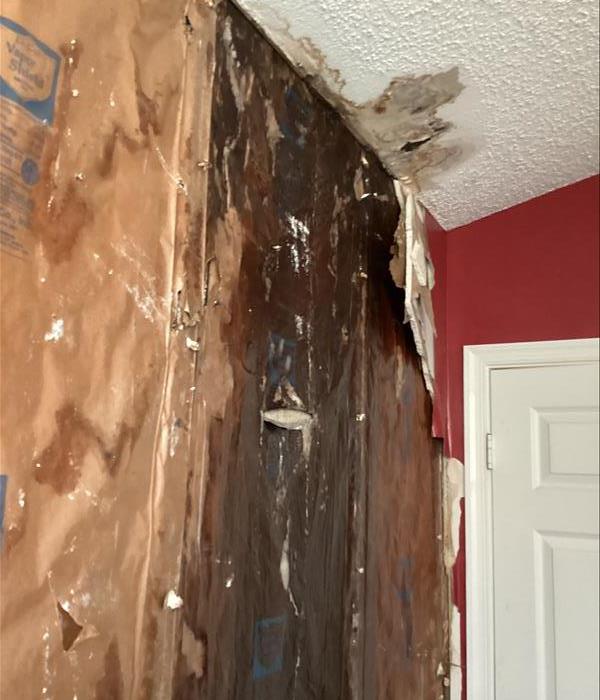 This home had an on-going roof leak that lead to harmful mold growth. SERVPRO of East Coral Springs was able to fully remediate the situation.
This home had an on-going roof leak that lead to harmful mold growth. SERVPRO of East Coral Springs was able to fully remediate the situation.
Mold growing in your Coral Springs home can cause a lot of damage, so it's important to know the types of molds that can be affecting your household. If you see mold or suspect that there is mold growing in your house, contact the certified professionals at SERVPRO® to test for and remove any mold from inside your home.
Cladosporium
Cladosporium is an airborne mold that can be found in soil and decaying plants. It can grow on wet, damp surfaces such as walls, ceilings, behind base boards, around toilets and other plumbing fixtures, and in shower stalls.
Alternaria
Alternaria is a common mold that can grow in homes. It can be found on plants, wood, and soil. It will also grow on fabrics and other household items if they are left damp for long periods of time. This type of mold grows best in dry areas with high temperatures, such as attics where there is little ventilation. Alternaria may also be present when there has been a flood or any other water damage to your home.
Aspergillus
This mold often grows on things like fabrics, ceiling tiles, and carpeting. It is a common type of mold to see after a water loss has occurred in your home or business. That is why it's important to call a certified drying team to properly dry wet materials after a leak or flood.
Penicillium
Penicillium is a type of fungus that can grow on many different types of food. It can be found in the soil, on plants, and on fruit and vegetables. Penicillium grows best when it's warm and damp, so you'll often find it indoors where there is high humidity locations such as Florida or moisture from leaks or flooding.
Aureobasidium
Aureobasidium is a fungus that grows on organic materials, such as house dust and plants. It can be found in homes, schools, and offices. This mold can grow on a wide variety of materials including wood products like particle boards or plywood; paper products such as books or cardboard boxes; and even upholstery fabrics like cotton or wool.
Mucor
Mucor is a fungus that can grow on food and other organic materials. It can be found in soil, air, and water; it grows on damp building materials such as wood, and cardboard. and plasterboard. Mucor spores are microscopic so they may not be visible to the naked eye.
Stachybotrys Atra
Stachybotrys Atra, also known as black mold, is a fungus that can grow on many surfaces, including wood, paper products, and textiles. Black mold is especially common on the wallboard.
It is important to know the types of mold that can grow in your home.
Mold is a fungus that grows in damp areas and doesn't need light to survive. It can be hard to see unless you're looking for it, but if you know what to look for and where to look, you'll be able to spot mold before it becomes a serious hazard to your health.
Mold likes humid places with poor ventilation like basements and crawl spaces, as well as inside walls or behind base boards. If there's enough moisture in your home or an area where there has been moisture build-up (like a bathroom), mold will grow there as well.
We hope this article has helped you understand the different types of molds that can grow in your home. If you're concerned that there might be mold in your house or business, please contact SERVPRO of East Coral Springs! (954) 406-7771
Mold Remediation
12/17/2019 (Permalink)
Molds are a natural part of the environment. They can be found anywhere there is water and moisture, so the key to controlling them in and around your home or business is moisture control. If mold is found in your home or business, you should clean up the mold promptly and fix the water problem immediately. It is also important to dry water-damaged areas and items within 24-48 hours to prevent mold growth.
Centers for Disease Control and Prevention offer resources for proper and safe mold cleanup. Click here for more information on mold cleanup information for you and your family.
If you feel you have mold or you're not sure if you have mold problems, please call SERVPRO of East Coral Springs 954-725-6400 and talk with one of our IICRC Certified Technicians.
Mold Growth n your home
11/19/2019 (Permalink)
Did you know that when a home suffers any type of water damage, mold infestations can arise within 48-72 hours throughout the home? Removing all mold in a home is impossible as they are microscopic spores living both inside and outside. In Florida, mold is incredibly common because it thrives on moisture and thus quickly grows into colonies where any water exposure exists. Unfortunately, mold spores produce a variety of irritants and allergens, making them potential health problems. As such, removing as much mold as possible is important for any homeowner, particularly for South Florida homeowners.
As such, being aware of the common places where mold grows is essential to reducing the mold damage and preventing future mold growth. The following are some of the most common places for home mold growth:
- Bathrooms and showers
- HVAC system drain pans
- Underneath kitchen sinks
- Areas surrounding refrigerators
- Carpets
- Crawlspaces
- Ceiling tiles
- Surrounding air conditioning units
- Stacks of paper/newspapers/cardboard boxes/etc. that are dampened or wet
- Areas surrounding any kind of cooling or heating appliances
While the above are some of the most common locations for mold growth, it is certainly not limited to those 10 areas. Nevertheless, consistently inspecting these common regions in your home will help to ensure that moisture is not creating mold growth.
If you suspect your home has mold, contact SERVPRO of East Coral Springs at 954-725-6400.
Tips to Prevent Mold Growth in your Bathroom
11/13/2019 (Permalink)
Heat and moisture accumulate on a regular basis in bathrooms, providing the perfect environment for mold to grow. Not only can mold impact the appearance of your bathroom, but it can also cause damage to your walls, floors, and ceilings and become a health hazard. Prevent mold by keeping the bathroom clean, eliminating moisture accumulation, and providing ventilation.
Here are 7 easy steps to prevent mold in your bathroom.
1. Dust and clean your bathroom regularly with all-purpose cleaner.
2. Wash your shower curtains and bath rugs frequently.
3. Check for sink or toilet leaks and get them repaired.
4. Keep your shower walls as dry as possible.
5. Don’t keep bathing products in your shower or tub.
6. Provide ventilation by using your exhaust fan and opening bathroom door and windows.
7. Use an air conditioner or dehumidifier to remove moisture from the air.
If you see signs of mold, call SERVPRO of East Coral Springs and our IICRC Certified Technicians are here help!
Call 954-725-6400.
Does your home or business have a mold problem?
11/4/2019 (Permalink)
Microscopic mold spores naturally occur almost everywhere, both outdoors and indoors. This makes it impossible to remove all mold from a home or business. Therefore, mold remediation reduces the mold spore count back to its natural or baseline level. Some restoration businesses advertise “mold removal” and even guarantee to remove all mold, which is a fallacy. Consider the following mold facts:
- Mold is present almost everywhere, indoors and outdoors.
- Mold spores are microscopic and float along in the air and may enter your home through windows, doors, or AC/heating systems or even hitch a ride indoors on your clothing or a pet.
- Mold spores thrive on moisture. Mold spores can quickly grow into colonies when exposed to water. These colonies may produce allergens and irritants.
- Before mold remediation can begin, any sources of water or moisture must be addressed. Otherwise, the mold may return.
- Mold often produces a strong, musty odor and can lead you to possible mold problem areas.
- Even higher-than-normal indoor humidity can support mold growth. Keep indoor humidity below 45 percent.
If your home or business has a mold problem, we can inspect and assess your property and use our specialized training, equipment, and expertise to re-mediate your mold infestation.
Mold and Your Home
12/19/2018 (Permalink)
Microscopic mold spores naturally occur almost everywhere, both outdoors and indoors. This makes it impossible to remove all mold from a home or business. Therefore, mold remediation reduces the mold spore count back to its natural or baseline level. Some restoration businesses advertise “mold removal” and even guarantee to remove all mold, which is a fallacy. Consider the following mold facts:
Mold is present almost everywhere, indoors and outdoors.
- Mold spores are microscopic and float along in the air and may enter your home through windows, doors, or AC/heating systems or even hitch a ride indoors on your clothing or a pet.
- Mold spores thrive on moisture. Mold spores can quickly grow into colonies when exposed to water. These colonies may produce allergens and irritants.
- Before mold remediation can begin, any sources of water or moisture must be addressed. Otherwise, the mold may return.
- Mold often produces a strong, musty odor and can lead you to possible mold problem areas.
- Even higher-than-normal indoor humidity can support mold growth. Keep indoor humidity below 45 percent.
If your home or business has a mold problem, we can inspect and assess your property and use our specialized training, equipment, and expertise to remediate your mold infestation.
If You See Signs of Mold, Call SERVPRO of East Coral Springs – 954-725-6400.
Mold Remediation
12/18/2018 (Permalink)
Molds are a natural part of the environment. They can be found anywhere there is water and moisture, so the key to controlling them in and around your home or business is moisture control. If mold is found in your home or business, you should clean up the mold promptly and fix the water problem immediately. It is also important to dry water-damaged areas and items within 24-48 hours to prevent mold growth.
Centers for Disease Control and Prevention offer resources for proper and safe mold cleanup. Click here for more information on mold cleanup information for you and your family.
If you feel you have mold or you're not sure if you have mold problems, please call SERVPRO of East Coral Springs 954-725-6400 and talk with one of our IICRC Certified Technicians.
Mold Growth In Your Home
11/27/2018 (Permalink)
Did you know that when a home suffers any type of water damage, mold infestations can arise within 48-72 hours throughout the home? Removing all mold in a home is impossible as they are microscopic spores living both inside and outside. In Florida, mold is incredibly common because it thrives on moisture and thus quickly grows into colonies where any water exposure exists. Unfortunately, mold spores produce a variety of irritants and allergens, making them potential health problems. As such, removing as much mold as possible is important for any homeowner, particularly for South Florida homeowners.
As such, being aware of the common places where mold grows is essential to reducing the mold damage and preventing future mold growth. The following are some of the most common places for home mold growth:
- Bathrooms and showers
- HVAC system drain pans
- Underneath kitchen sinks
- Areas surrounding refrigerators
- Carpets
- Crawlspaces
- Ceiling tiles
- Surrounding air conditioning units
- Stacks of paper/newspapers/cardboard boxes/etc. that are dampened or wet
- Areas surrounding any kind of cooling or heating appliances
While the above are some of the most common locations for mold growth, it is certainly not limited to those 10 areas. Nevertheless, consistently inspecting these common regions in your home will help to ensure that moisture is not creating mold growth.
If you suspect your home has mold, contact SERVPRO of East Coral Springs at 954-725-6400.
Tips to Prevent Mold in a Bathroom
11/20/2018 (Permalink)
Heat and moisture accumulate on a regular basis in bathrooms, providing the perfect environment for mold to grow. Not only can mold impact the appearance of your bathroom, but it can also cause damage to your walls, floors, and ceilings and become a health hazard. Prevent mold by keeping the bathroom clean, eliminating moisture accumulation, and providing ventilation.
Here are 7 easy steps to prevent mold in your bathroom.
1. Dust and clean your bathroom regularly with all-purpose cleaner.
2. Wash your shower curtains and bath rugs frequently.
3. Check for sink or toilet leaks and get them repaired.
4. Keep your shower walls as dry as possible.
5. Don’t keep bathing products in your shower or tub.
6. Provide ventilation by using your exhaust fan and opening bathroom door and windows.
7. Use an air conditioner or dehumidifier to remove moisture from the air.
If you see signs of mold, call SERVPRO of East Coral Springs and our IICRC Certified Technicians are here help! Call 954-725-6400.
Mold Remediation the Safe Way!
11/14/2018 (Permalink)
Is it ok to use bleach on mold, in place of conducting a proper mold remediation?
No!
For one thing, IICRC Mold Remediation Guidelines according to the IICRC:
People use bleach to "kill" mold. Most importantly, the IICRC emphasizes that even dead mold spores (also referred to as "non-viable" spores) remain toxigenic and allergenic. While it is true that if a person kills spores (something that we shouldn't assume is happening), the good news is those spores will not grow. However, if the dead spores retain their toxic and allergenic properties what is the point of killing them? Remediate them fully -- remove them using the proper containment techniques that prevents cross-contamination to surrounding areas. Call SERVPRO today to get your mold issues taken care of right away 954-725-6400.
SERVPRO uses green products to eliminate mold to ensure your safety. SERVPROxide delivers a KO punch to eliminate mold, mildew, viruses, bacteria and odors!
Does your home or business have a problem with mold ?
10/17/2018 (Permalink)
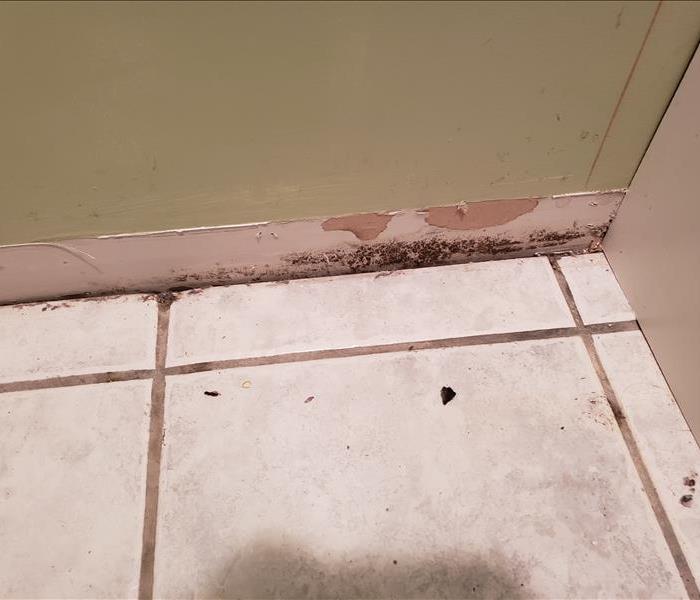 Does your home or business have a problem with mold ?
Does your home or business have a problem with mold ?
Microscopic mold spores naturally occur almost everywhere, both outdoors and indoors. This makes it impossible to remove all mold from a home or business. Therefore, mold remediation reduces the mold spore count back to its natural or baseline level. Some restoration businesses advertise “mold removal” and even guarantee to remove all mold, which is a fallacy. Consider the following mold facts:
- Mold is present almost everywhere, indoors and outdoors.
- Mold spores are microscopic and float along in the air and may enter your home through windows, doors, or AC/heating systems or even hitch a ride indoors on your clothing or a pet.
- Mold spores thrive on moisture. Mold spores can quickly grow into colonies when exposed to water. These colonies may produce allergens and irritants.
- Before mold remediation can begin, any sources of water or moisture must be addressed. Otherwise, the mold may return.
- Mold often produces a strong, musty odor and can lead you to possible mold problem areas.
- Even higher-than-normal indoor humidity can support mold growth. Keep indoor humidity below 45 percent.
If your home or business has a mold problem, we can inspect and assess your property and use our specialized training, equipment, and expertise to remediate your mold infestation.
Does Your Home Have Mold ?
12/20/2017 (Permalink)
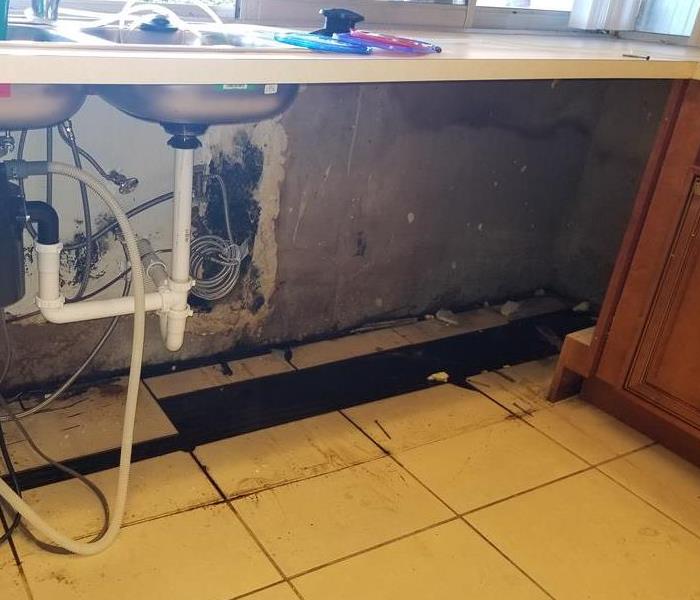 These kitchen cabinets had to removed do to mold.
These kitchen cabinets had to removed do to mold.
Microscopic mold spores naturally occur almost everywhere, both outdoors and indoors. This makes it impossible to remove all mold from a home or business. Therefore, mold remediation reduces the mold spore count back to its natural or baseline level. Some restoration businesses advertise “mold removal” and even guarantee to remove all mold, which is a fallacy. Consider the following mold facts:
Mold is present almost everywhere, indoors and outdoors.
- Mold spores are microscopic and float along in the air and may enter your home through windows, doors, or AC/heating systems or even hitch a ride indoors on your clothing or a pet.
- Mold spores thrive on moisture. Mold spores can quickly grow into colonies when exposed to water. These colonies may produce allergens and irritants.
- Before mold remediation can begin, any sources of water or moisture must be addressed. Otherwise, the mold may return.
- Mold often produces a strong, musty odor and can lead you to possible mold problem areas.
- Even higher-than-normal indoor humidity can support mold growth. Keep indoor humidity below 45 percent.
If your home or business has a mold problem, we can inspect and assess your property and use our specialized training, equipment, and expertise to remediate your mold infestation.
If You See Signs of Mold, Call Us Today – 954-725-6400
Information On Getting Mold Cleaned Up
12/19/2017 (Permalink)
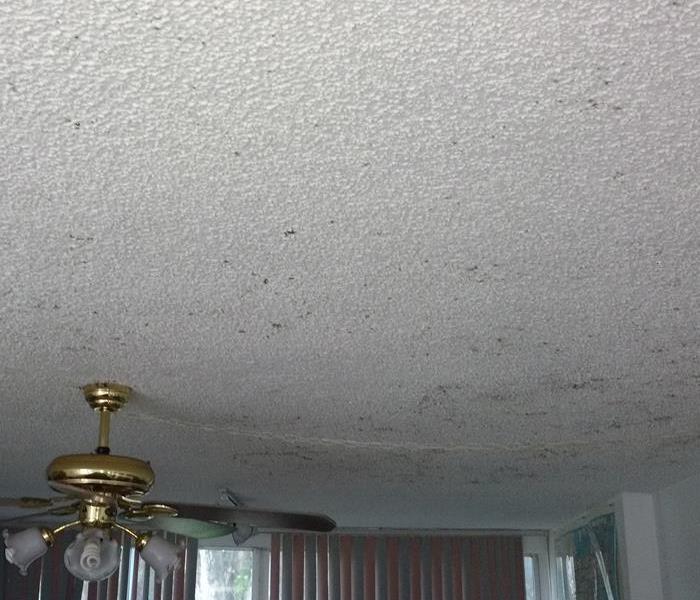 The ceiling in this home is covered with mold as you can see in the picture.
The ceiling in this home is covered with mold as you can see in the picture.
Molds are a natural part of the environment. They can be found anywhere there is water and moisture, so the key to controlling them in and around your home or business is moisture control. If mold is found in your home or business, you should clean up the mold promptly and fix the water problem immediately. It is also important to dry water-damaged areas and items within 24-48 hours to prevent mold growth.
Centers for Disease Control and Prevention offer resources for proper and safe mold cleanup. Click here for more information on mold cleanup information for you and your family.
If you feel you have mold or your not sure if you have mold problems please call SERVPRO of East Coral Springs 954-725-6400
Most Common Places For Home Mold
11/28/2017 (Permalink)
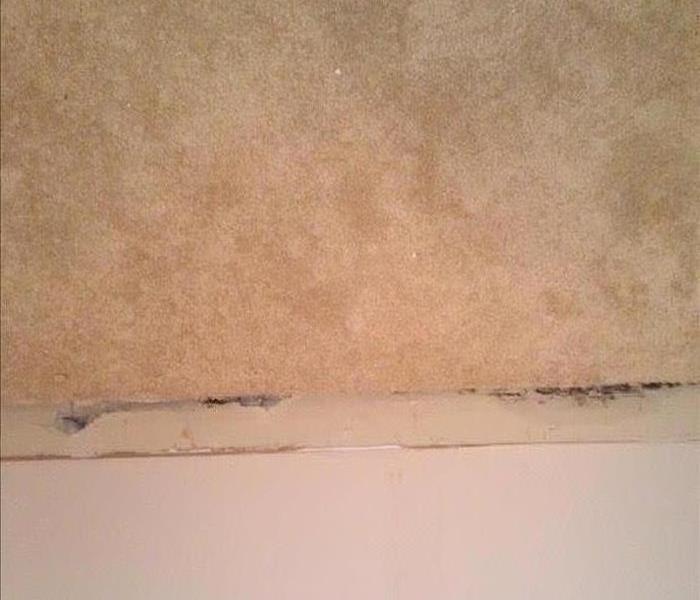 This mold needs to be removed immediately. Now that you know what your looking for you will be able to inspect your own home.
This mold needs to be removed immediately. Now that you know what your looking for you will be able to inspect your own home.
When a home suffers any type of water damage, mold infestations can arise within 48-72 hours throughout the home. Removing all mold in a home is impossible as they are microscopic spores living both inside and outside. In Florida, mold is incredibly common because it thrives on moisture and thus quickly grows into colonies where any water exposure exists. Unfortunately, mold spores produce a variety of irritants and allergens, making them potential health problems. As such, removing as much mold as possible is important for any homeowner, particularly for South Florida homeowners.
As such, being aware of the common places where mold grows is essential to reducing the mold damage and preventing future mold growth. The following are some of the most common places for home mold growth:
- Bathrooms and showers
- HVAC system drain pans
- Underneath kitchen sinks
- Areas surrounding refrigerators
- Carpets
- Crawlspaces
- Ceiling tiles
- Surrounding air conditioning units
- Stacks of paper/newspapers/cardboard boxes/etc. that are dampened or wet
- Areas surrounding any kind of cooling or heating appliances
While the above are some of the most common locations for mold growth, it is certainly not limited to those 10 areas. Nevertheless, consistently inspecting these common regions in your home will help to ensure that moisture is not creating mold growth.
How To Prevent Mold In A Bathroom
11/27/2017 (Permalink)
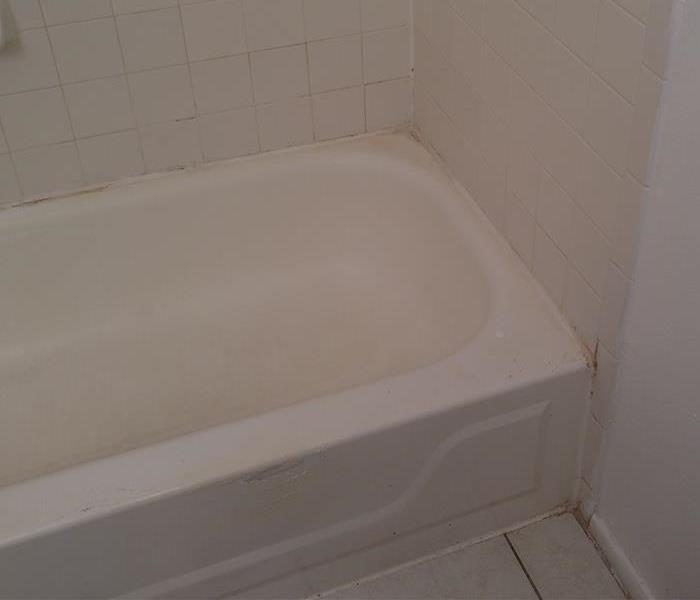 This is a bathroom that had mold problems the picture was taken before we cleaned the bathroom and removed the mold.
This is a bathroom that had mold problems the picture was taken before we cleaned the bathroom and removed the mold.
Heat and moisture accumulate on a regular basis in bathrooms, providing the perfect environment for mold to grow. Not only can mold impact the appearance of your bathroom, but it can also cause damage to your walls, floors, and ceilings and become a health hazard. Prevent mold by keeping the bathroom clean, eliminating moisture accumulation, and providing ventilation.
Here are 7 easy steps to prevent mold in your bathroom.
1. Dust and clean your bathroom regularly with all-purpose cleaner.
2. Wash your shower curtains and bath rugs frequently.
3. Check for sink or toilet leaks and get them repaired.
4. Keep your shower walls as dry as possible.
5. Don’t keep bathing products in your shower or tub.
6. Provide ventilation by using your exhaust fan and opening bathroom door and windows.
7. Use an air conditioner or dehumidifier to remove moisture from the air.
Is Bleach safe to be used to remove mold ?
11/16/2017 (Permalink)
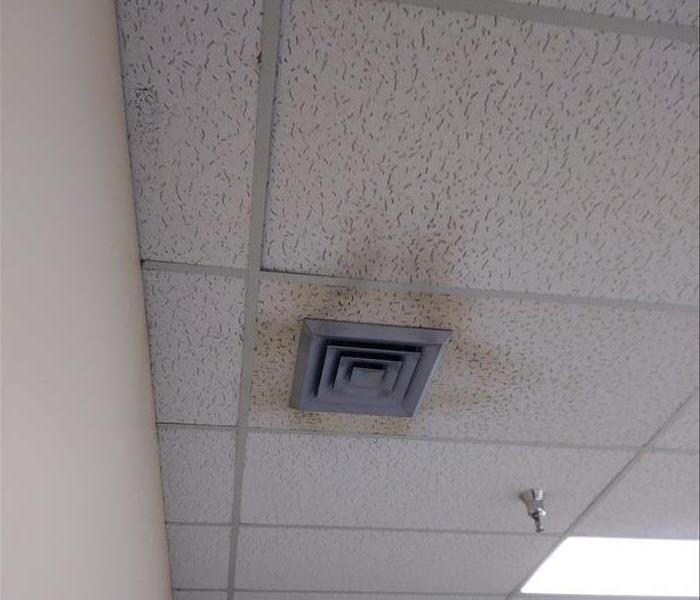 Notice the mold around the air duct
Notice the mold around the air duct
Is it ok to use bleach on mold, in place of conducting a proper mold remediation?
No!
For one thing, IICRC Mold Remediation Guidelinesaccording to the IICRC:
People use bleach to "kill" mold. Most importantly, the IICRC emphasizes that even dead mold spores (also referred to as "non-viable" spores) remain toxigenic and allergenic. While it is true that if a person kills spores (something that we shouldn't assume is happening), the good news is those spores will not grow. However, if the dead spores retain their toxic and allergenic properties what is the point of killing them? Remediate them fully -- remove them using the proper containment techniques that prevents cross-contamination to surrounding areas. Call SERVPRO today to get your mold issues taken care of right away 954-725-6400.
SERVPRO uses green products to eliminate mold to ensure your safety. SERVPROxide delivers a KO punch to eliminate mold, mildew, viruses, bacteria and odors!
 Mold was discovered in this Parkland home during a kitchen remodel. SERVPRO was contacted right away and was able to professionally remediate it.
Mold was discovered in this Parkland home during a kitchen remodel. SERVPRO was contacted right away and was able to professionally remediate it.





 24/7 Emergency Service
24/7 Emergency Service

